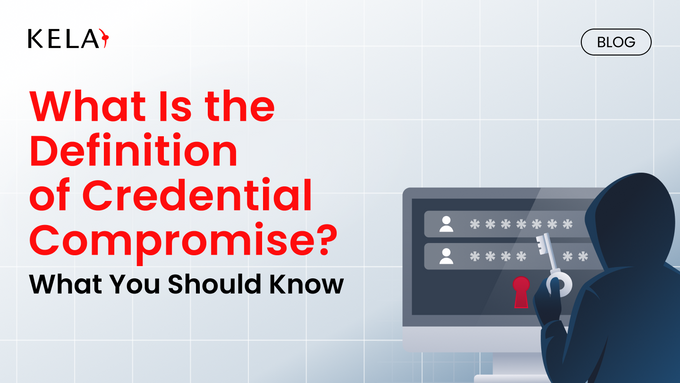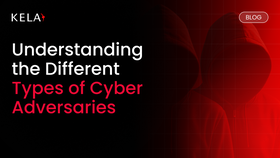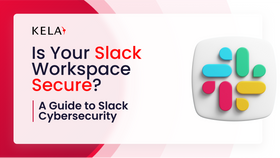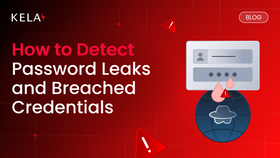What Is the Definition of Credential Compromise? What You Should Know
Credential compromises give attackers access to systems using stolen login details, often without immediate detection. This blog explains what is the definition of credential compromise, and ways to reduce the risk.
Updated July 20, 2025

Compromised credentials remain one of the most common and dangerous ways attackers gain access to sensitive systems and data. With an estimated 4 billion compromised credentials currently circulating, these stolen login details—whether obtained through phishing, malware, or exposed databases can open the door to further breaches and long-term damage.
To truly strengthen your security posture, it's essential to understand what defines a credential compromise and how it differs from other threats. In this blog, we will look at how credential compromises occur, what makes them so impactful, and how your business can reduce the risk.
» Get started for free with KELA and strengthen your cybersecurity
What Is a Credential Compromise in Cybersecurity?
Credential compromise occurs when unauthorized individuals obtain legitimate login details. This allows them to impersonate authorized users and gain unauthorized access to systems and data. It creates a serious risk because attackers can use this access to carry out data theft or financial fraud.
Differences Between Credential Compromise and Other Cyber Intrusions
- Focus on access vs. data: Credential compromise targets authentication information for access, while other breaches may directly exfiltrate data through vulnerabilities without using legitimate credentials.
- Nature of the compromised asset: Credential compromise involves stealing authentication identifiers, whereas other intrusions may exploit vulnerable software or physical access.
- Immediate impact and next steps: Credential compromise leads to unauthorized access and enables attackers to leverage compromised accounts for reconnaissance and escalation. Other attacks may disrupt services or deploy malware without initial user login.
- Detection challenges: Compromised credential attacks can be difficult to detect, as they mimic legitimate user behavior, especially with valid credentials. In contrast, other intrusions often trigger alerts due to identifiable malware or software vulnerabilities.
» Learn how leaked credentials differ from compromised accounts
Commonly Targeted Credentials and Their Value
Attackers target various credentials for their malicious activities, each presenting unique advantages. The following outlines common credentials and their significance:
- Usernames and passwords: These fundamental credentials are the most frequently targeted. They serve as primary access keys to online accounts such as email and banking. Their value lies in the prevalence of password reuse and the vulnerability of weak passwords. This makes them susceptible to brute-force attacks.
- API keys and access tokens: With the rise of cloud services, these credentials have become increasingly targeted. They provide programmatic access to applications and services. Attackers use them to automate data theft or service disruption. Vulnerabilities arise when they are hardcoded into applications or exposed in insecure environments.
- Session tokens and cookies: Attackers often steal active session tokens or cookies. These allow them to hijack authenticated user sessions. This bypasses the need for traditional credentials. Vulnerabilities stem from poor session management and interception techniques.
- Privileged account credentials (e.g., administrator, root): These credentials grant extensive control over systems and networks. Attackers exploit them for ransomware deployment and data exfiltration. They are vulnerable to targeted attacks or privilege escalation from compromised accounts.
- Cloud service credentials (e.g., AWS, Azure, GCP keys, or tokens): As organizations transition to cloud environments, these credentials are prime targets. Their compromise leads to unauthorized access and large-scale data breaches. Misconfigurations and exposure in code increase their vulnerability.
- Personally identifiable information (PII) for authentication or recovery: Details like names and Social Security numbers help with account recovery, but they’re also valuable to attackers. When this information is exposed, it can be sold on the dark web and used to take over accounts.
Take note: KELA's Identity Guard provides in-depth monitoring of the dark web and other illicit markets, offering insights into compromised credentials that are traded or discussed in these hidden spaces.
» Understand how threat actors breach and exploit your data
Understanding Compromised Credentials: Methods and Weaknesses
Attackers use several well-established methods to steal login credentials. Each method targets specific weaknesses in employee behavior, corporate security policies, or IT infrastructure. Below are the most common methods and the vulnerabilities they typically exploit.
1. Phishing and Spear Phishing
Attackers send deceptive emails and text messages (smishing), or create fake websites that mimic legitimate organizations. The goal is to trick recipients into entering their login credentials. Spear phishing goes further by targeting specific individuals using information gathered from previous breaches or public sources.
Key weaknesses targeted
- Employee behavior: People often click on unsafe links and enter their credentials because they trust the communication, or they simply aren't aware of the risks.
- Company security policies: Many organizations lack strong email security measures and don't provide enough training to their employees.
- IT infrastructure: Weak email filters and a lack of browser isolation can fail to block sophisticated phishing campaigns.
Did you know? According to Tech.co’s 2025 report, phishing attacks caused 40% of data breaches in 2024, up from 23% in 2023.
» Learn how to prevent phishing attacks before they catch you
2. Credential Stuffing
Attackers use automated tools to test stolen username and password combinations from earlier breaches across multiple platforms.
Key weaknesses targeted
- Employee behavior: Users frequently reuse the same passwords for different online accounts.
- Company security policies: Companies sometimes have poor enforcement of multi-factor authentication and weak rules for creating strong passwords.
- IT infrastructure: A lack of bot detection and monitoring for repeated failed login attempts can allow large-scale automated attacks to go unnoticed.
3. Malware
Malware is secretly installed on devices through malicious attachments, downloads, or compromised websites. Keyloggers record keystrokes to capture credentials, while infostealers collect saved login information from browsers and applications.
Key weaknesses targeted
- Employee behavior: Users may have unsafe downloading habits and click on malicious content.
- Company security policies: There might be a lack of strict rules for software downloads and unchecked "bring your own device" (BYOD) practices.
- IT infrastructure: Missing security patches and outdated endpoint protection software can leave systems vulnerable.
» Don’t overlook the real threat—learn how infostealers put your data at risk
4. Brute-Force and Password Spraying Attacks
Brute-force attacks involve systematically guessing passwords until the correct one is found. Password spraying applies a small set of commonly used passwords across many accounts, avoiding lockouts and increasing chances of success.
Key weaknesses targeted
- Employee behavior: People often use weak or easily guessable passwords for their accounts.
- Company security policies: Companies sometimes have inadequate requirements for password complexity and weak mechanisms for locking out accounts after multiple failed login attempts.
- IT infrastructure: Authentication systems may be exposed without rate limiting or other protections that would prevent rapid, repeated guessing attempts.
» Make sure you understand the most targeted entry points by attackers
Risks Businesses Face From Credential Compromises
Credential compromises expose businesses to a wide range of risks that affect operations, finances, reputation, and regulatory compliance. These risks can have immediate consequences and also create long-lasting challenges that require ongoing attention and resources.
Operational Risks
- In the short term, credential compromises cause system downtime and disrupt business operations. Internal teams must focus on incident response, which pulls them away from normal work. Attackers may lock out users or deploy ransomware, cutting off access to critical data.
- Over the long term, restoring systems and enhancing monitoring can take months. Attackers may maintain covert access, stealing data or causing disruptions. The breach may reveal IT weaknesses which can require costly upgrades.
» Read more: Ransomware groups are selling network access directly
Financial Risks
- In the short term, credential compromises lead to high costs for forensic investigations, legal counsel, and overtime for IT staff. Attackers may exploit stolen credentials to commit fraudulent transactions. Organizations might pay ransoms to regain access or prevent data leaks.
- Over the long term, a damaged reputation always means less money coming in and customers leaving. It also often causes cyber insurance costs to jump up a lot, or it can become much harder to even get insurance. Plus, when important company secrets are stolen, it lessens a company's edge over competitors and harms its future profits.
Reputational Risks
- In the short term, breaches bring negative media coverage and public scrutiny. Customers and partners lose trust and may disengage. Employee morale may decline, fostering internal distrust.
- Over the long term, repairing brand damage is costly and difficult. Customer loyalty, investor confidence, and talent acquisition suffer. The stigma of a breach hinders attracting and retaining customers and partners. Competitors may gain market advantage due to reputational harm.
Regulatory Risks
- In the short term, organizations face costly and complex breach notification requirements. Regulatory inquiries and investigations typically follow quickly. Immediate sanctions or corrective orders may be imposed.
- Over the long term, significant fines may be levied for non-compliance with data protection laws. Mandated security audits and increased compliance reporting add to operational costs. Litigation and class action lawsuits from affected individuals can lead to lengthy legal battles.
» Learn more: How scary is that data leak, really?
Preventive Measures for Credential Compromises
- Enforce strong password policies: Organizations must require complex and unique passwords for all accounts and encourage the use of password managers. Policies should prohibit password reuse and include regular checks against breached credential databases.
- Conduct security awareness training: Employees need to learn how to spot and report phishing, recognize social engineering tactics, and manage their login information safely. Since 74% of breaches involve a human element, continuous user training is critical to reducing risk.
- Implement MFA: Organizations should mandate MFA for all user accounts, especially those with privileged access or connecting to sensitive systems via remote points like VPNs. According to Microsoft, MFA can prevent 99.9% of credential-based compromises, greatly reducing the risk posed by stolen passwords.
» Find out why your organization needs cyber threat intelligence
How KELA Cyber Helps You Stay Ahead of Compromised Credentials
Compromised credentials are a common entry point for attackers, but your business can take action before damage occurs. At KELA Cyber, we help you stay ahead by monitoring dark web sources, forums, and infostealer logs for any credentials linked to your domains and services.
KELA's Identity Guard platform delivers real-time alerts and context-rich intelligence, allowing your security teams to respond quickly and effectively. With insights into attacker behavior and automated threat prioritization, we support your efforts to detect, monitor, and contain credential threats proactively.
» Looking for the solution? Look no further than KELA
FAQs on Compromised Credentials
What is the definition of credential compromise?
Credential compromise refers to a security incident where attackers gain unauthorized access to valid login details, such as usernames, passwords, tokens, or API keys.
What risks does a credential compromise pose to an organization?
Risks include operational disruption, financial losses, reputational damage, and regulatory consequences that can escalate if attackers exploit compromised credentials.
How can businesses identify compromised credentials early?
Early detection involves monitoring cybercrime sources for exposed credentials linked to company assets. A platform like KELA delivers real-time alerts and threat intelligence to support timely action.





